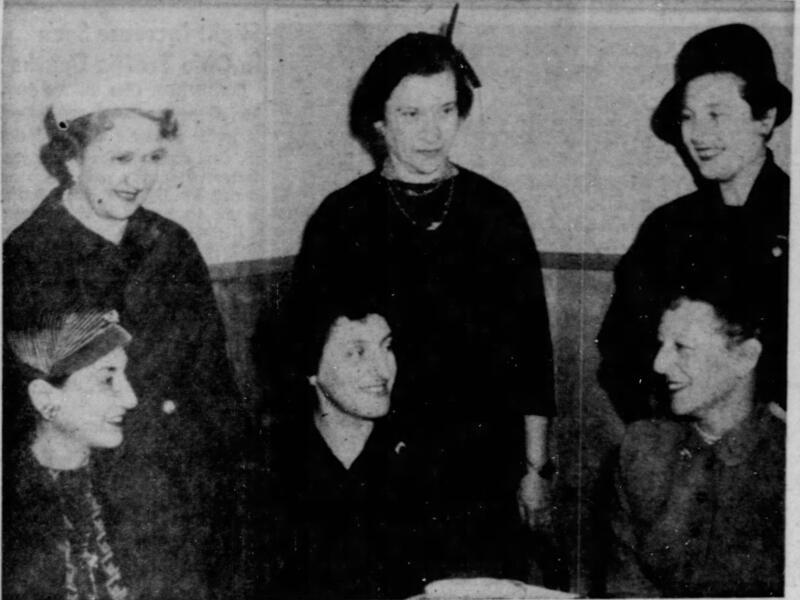When Women Led Small-Town Jewish Life
I first came across Salem, Ohio’s Jewish history while researching the nearby community of Alliance, just 14 miles west, which once had around 40 Jewish families and a synagogue. In comparison, Salem—a town of under 13,000 people—seemed unlikely to have ever had much of a Jewish presence. That is, until I discovered the story of a powerful women’s group that, for nearly two decades, kept Jewish life and civic connection alive in northern Columbiana County.
In October 1948, local Jewish women organized a branch of the National Council of Jewish Women (NCJW)—believed at the time to be the smallest NCJW section in the country. At its peak, it had just 20 members, but the group left an outsized imprint on the civic life of the town.
To further Jewish life and interfaith understanding, they hosted Hanukkah and Purim celebrations, organized community dinners and summer picnics, and offered visible leadership on behalf of the Jewish community. During Brotherhood Week—a mid-twentieth-century national campaign to promote tolerance as an American value—they didn’t just participate. In 1955, they led the program itself, organizing a public tea and inviting women from across Salem’s civic groups to hear a Unitarian minister speak on interfaith understanding. Their leadership was both symbolic and practical, creating spaces where Jewish women stood at the heart of civic cooperation and interfaith dialogue.
Philanthropically, the Salem NCJW chapter donated school supplies to Israel, sent relief packages to war-torn Europe, and supported local causes like the Heart Fund, the Red Cross, and the Community Chest. At a time when no synagogue or Federation office existed in town, this tiny NCJW group became the voice of Jewish communal life in Salem.
As part of the country’s oldest grassroots Jewish women’s organization, these women were living out NCJW’s enduring mission: to build bridges, pursue justice, and anchor community through service. Though small in number, they saw themselves as part of something far larger: an intergenerational effort to promote equality, interfaith dialogue, and public service rooted in Jewish values. Even in a town where they were the only Jewish organization, these women made Salem a part of the national NCJW story.
Among its leaders was Goldie Schwartz, who moved to Salem from New Jersey in 1916 and became one of the town’s most visible civic figures. After her husband's death, she managed the Schwartz Department Store while also serving on the boards of the Salvation Army, the Northern Columbiana County Hospital Association, and the Chamber of Commerce. In 1952, she was elected president of Salem’s NCJW section—one of many Jewish women who carried forward both their families’ livelihoods and the spiritual and communal traditions of Jewish life.
Another NCJW president, Eva Chentow, brought her background in education to the town. Originally a teacher in Connellsville, Pennsylvania, she moved to Salem after marrying Hyman Chentow in 1940. After his death in 1961, she took over the family furniture store, all while staying active in the League of Women Voters and leading NCJW’s efforts into the 1960s.
And then there was Liesel Falkenstein, born in Germany in 1909. A refugee from Nazism, she came to the United States in 1938 with her husband Alfons and settled in Salem by 1945. Liesel built a new life in small-town Ohio—thousands of miles from the turmoil she had fled—and poured her energy into the League of Women Voters and the Columbiana County Medical Society Auxiliary. Through her civic involvement and resolute leadership, she helped root Jewish values of justice and healing in her new community.
Today, no organized Jewish community remains in Salem. But thanks to the women of NCJW, the values they carried—compassion, dignity, and public service—still echo. Their story reminds us that even the smallest group can be mighty, and that Jewish women have always found ways to lead, no matter the size of their community.
And the legacy of this leadership extended far beyond Salem. The children of the Jewish women who sustained NCJW went on to shape fields as varied as diplomacy, journalism, law, and business. Herbert Hansell served as a legal advisor to Secretary of State Cyrus Vance and played a major role in negotiating the Camp David Accords and other landmark diplomatic agreements. Others like Harvey Walken, a former real estate investor with ownership ties to the Pittsburgh Pirates and Toronto’s SkyDome, and Robert Schwartz, a longtime New York Bureau Chief for Time Magazine, trace their stories back to Salem’s small Jewish community. Their successes—like their values—were shaped by the civic example modeled by the women of NCJW.
Though Salem’s NCJW chapter dissolved in 1964, its spirit lives on—not just in the archives, but in the ripples of change and leadership its members helped inspire. These women didn’t just sustain Jewish life in a small Ohio town; they helped shape lives that would, in turn, shape the cultural and civic landscape of the nation.
Preserving stories like Salem’s challenges our assumptions about where Jewish history happens—and who gets remembered. It reminds us that Jewish women’s leadership has never been confined to large cities or national headlines. And it offers a lesson for today’s institutions: small groups can leave mighty legacies. Their memory is not only a source of pride—it’s a call to action.







Great story about American history and the positive impact made by the immigrants who are the backbone of each of our communities. A powerful reminder that a small minority in this case the Jewish women of Salem can create a legacy. May their memory be eternal